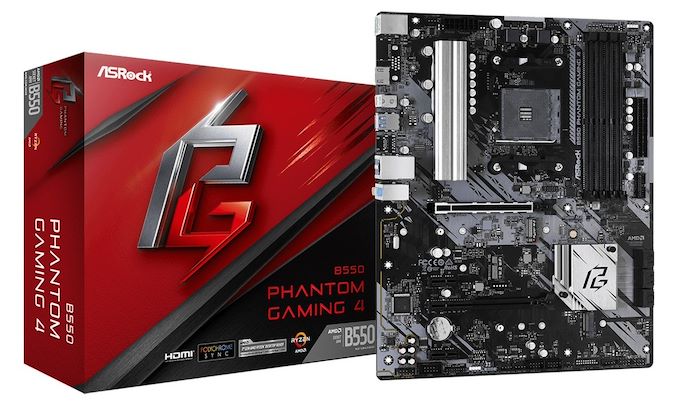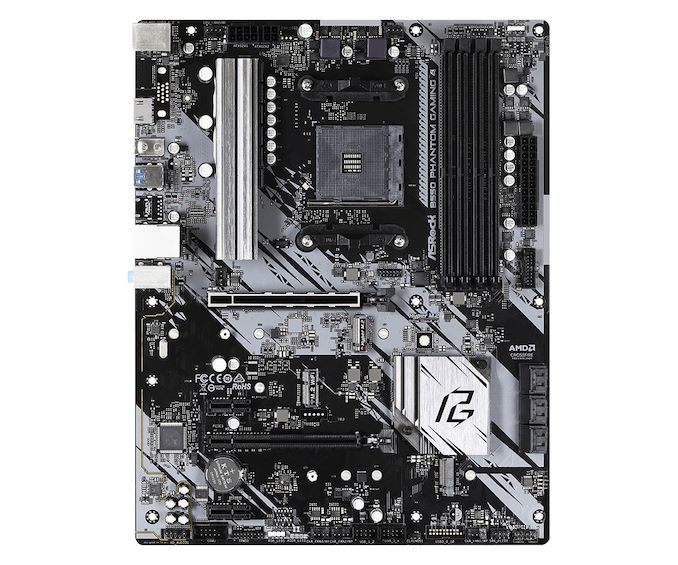The AMD B550 Motherboard Overview: ASUS, GIGABYTE, MSI, ASRock, and Others
by Dr. Ian Cutress & Gavin Bonshor on June 16, 2020 11:00 AM ESTASRock B550 Phantom Gaming 4 + 4ac
For this segment, we’re covering two motherboards: the ASRock B550 Phantom Gaming 4, and the ASRock B550 Phantom Gaming 4ac. The difference between the two, you would think given the name, is that the AC model has Wi-Fi 5 installed. There is another subtle difference, in that the standard PG4 has six SATA ports, whereas the PG4ac model only has four. This is despite both models still having the same PCIe layout, so we’re unsure why there is a difference. Nonetheless the rest of the boards are the same.
As we move to the cheaper end of the B550 range, we move to the motherboards that do not have rear-IO covers, and more limited power delivery and chipset cooling. Despite the PG4 box being red, the board itself is a lot more silver, playing into the Phantom Gaming theme, but with fewer heatsinks there is less to actually cover. For the power delivery here, for example, there is a single heatsink on the left hand side where all six phases for the CPU are. The chipset heatsink is a lot smaller, and neither of the M.2 slots have heatsinks either.
The CPU is powered by an 8-pin and a 4-pin, and the socket area has easy access to three 4-pin fan headers as needed. The motherboard still has a full complement of DDR4 slots, and these are single sided latch variants.
On the right hand side of the motherboard there is a USB 3.0 header, SATA ports, but no power/reset buttons. On the bottom there is an audio header, a COM header, a TPM header, RGB LED headers, three more 4-pin fan headers, two USB 2.0 headers, and a front panel header.
The PCIe layout puts a full PCIe 4.0 x16 slot at the top with additional reinforcement, directly above the PCIe 4.0 x4 M.2 slot for storage. There is an M.2 Wi-Fi slot underneath this, which with the PG4ac is filled with an Intel AC3168 1x1 solution, one of the cheapest 802.11ac modules you can get. There is a full length PCIe 3.0 x4 slot from the chipset, and underneath this is another M.2 slot, this time PCIe 3.0 x2 from the chipset.
The audio section on the right hand side is using an upgraded ALC1200 audio codec, with PCB separation and filter caps. Unlike the other ALC1200 variants we’ve seen from ASRock, this board only has three audio outputs.
On the rear panel we have a combination PS/2 port, six USB 3.2 Gen 1 ports, a HDMI output, and a single Realtek RTL8111H gigabit Ethernet port. There are no USB 3.2 Gen 2 ports on this motherboard.













101 Comments
View All Comments
Operandi - Tuesday, June 16, 2020 - link
Looks like some nice mATX versions this round, nice!YB1064 - Thursday, June 18, 2020 - link
I was hoping to see a $75-$90 board.kenjiwing - Tuesday, June 16, 2020 - link
Fortunately, this component is a unique motherboard among B550 and well worth reading up on [add link].Needs to be edited.
anirudhs - Tuesday, June 16, 2020 - link
There's a noise sensor which can adjust fan speed for maximum quietness with good thermals. Saw it on the KitGuruTech video. The noise sensor isn't there to spy on you though.PeterCollier - Wednesday, June 17, 2020 - link
The quality of the editing here is shit tier. Seriously, just run the articles through Grammarly before publication. It's free and it spots plenty of errors.Heavenly71 - Tuesday, June 16, 2020 - link
Sadly none of the mITX boards have more than 6 external USB ports. My old ASUS mITX has 8! And in really small mITX cases you can't add a bracket with more USB, because the two brackets are already used by the gfx card. Guess I have to wait for an enthusiast mITX board )-:damianrobertjones - Tuesday, June 16, 2020 - link
Or, just maybe, get a usb dongle with 4 ports?Mr Perfect - Tuesday, June 16, 2020 - link
That is disappointing. The number of USB devices people need to plug in can't be dropping, surely? I know I've got more now then even a year ago.rrinker - Tuesday, June 16, 2020 - link
Are they really going up? I have 2 USB devices plugged in to my system - a keyboard and a mouse. I occasionally plug a USB stick in one of the front ports to transfer files. My phone and tablet sync over wifi, they don't get plugged in. I have a charger behind my desk and a cable to charge them. My printer is on the network.The one place I DO need lots of USB ports is also the place where I have a small cube case machine, with no discreete GPU, because it doesn;t need one. On that one I added a USB PCI card to get enough ports. In addition to the keyboard and mouse, that machine is on my workbench where it connects to several electronic test instruments and I have multiple cabled for programming microcontrollers. I also have a USB microscope for board inspection. And then I have 3 more USB devices connected for my other hobby that shares the bench. Plus a front port kept free for USB sticks.
So the use case I have for more USB has the PCI slots open to add expansion cards, the use case where I have a discrete GPU eating up the slot space doesn't need an excess of USB ports.
DigitalFreak - Tuesday, June 16, 2020 - link
I use 3 USB 3.0 ports just for my Oculus Rift